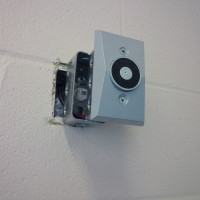How many violations do you see?


I enjoy posting photographs submitted by code inspectors. This one is from Kelly Anbach of South Carolina. What would you do as an inspector if a neighbor complained?

Yesterday I had the privilege of teaching Advanced Legal Aspects of Code Enforcement for Property Maintenance Inspectors for the Missouri Association of Code Enforcement at Lake of the Ozarks, MO. Today I read the headlines about the 8 children killed in a fire in a building in Chicago with code violations. The owner was already in court for this building that the Chicago Sun-Times said was without working smoke detectors. I remember telling the inspectors yesterday that they save lives by doing their jobs and that rental inspection programs are a key part of enforcement. It is just so sad that this loss of life happens when these tragedies can be prevented yet some landlords resist spending the money necessary to ensure their buildings are safe. In Illinois we have tried to get legislation passed so that non-home rule communities can license landlords but the proposed bills always die because of opposition by those who do not care enough about the safety of the public. What a waste of young lives.
Having prosecuted many owner/landlords, I have heard lots of excuses for the violations on their properties but they are all very similar. I started pondering this after reading an article about an owner/landlord in West Virginia who complained he was being harassed and singled out over properties he owned. These “defenses” fall into the following categories:
Some of these may be legitimate reasons but often not legal defenses. My response to these types of arguments are:
Rarely does anything legitimate come up in these conversations. Do any of my readers have other great excuses? I will publish the best ones.
What can be done when a defendant refuses to obey a court order, whether it’s fixing up properties or turning over documents? The solution is the contempt power of the court which is the way that the court enforces its orders. Without it, court orders would be toothless and unenforceable. The court can order the defendant to be jailed until he or she complies or impose daily fines until there is compliance. Most defendants will comply if there is such a threat. The prosecutor usually begins the process by filing a document known as a rule to show cause why the defendant should not be held in contempt of court. The defendant then gets an opportunity to show why he or she shouldn’t, usually by complying with the order. This is why it’s so important to have the court issue an order and then set a deadline for compliance. Once that date passes without compliance, the prosecutor can file such a motion and begin the process. Without it, justice would grind to a halt. In a Milwaukee case, a court appointed manager is asking the court to hold a defendant in contempt for failing to turn over records so the manager can do his job regarding the defendant’s properties. Every court is vested with this power so it can enforce its orders. Without it, enforcement against recalcitrant owners would be impossible.
Failure to retrofit older residential high rises with sprinklers continues to be controversial given the recent publicity surrounding the death of a man because of a fire in Trump Tower in New York. Building owners contend the cost of retrofitting is too expensive and that other safety measures can be taken. The Society of Fire Protection Engineers (SFPE) discusses the problem in an article entitled High-rise Buildings: What Should We Do About Them?
While the article is not recent, it is a thoughtful analysis of the history involved in this struggle.
A firefighter tragically died in Chicago recently when responding to a call. Unbeknownst to him, the elevator shaft was open where the elevator was being removed, allegedly with no permit. Because of the smoke, he had no way of knowing about this hazard and was killed in the fall. I have been preaching for years about the danger of working without a permit. People cut corners and don’t get the proper permits usually due to the cost or because they don’t want government scrutiny. People die because of this and first responders are often the victims.
I recently had my own experience regarding permits when we needed a new furnace. After speaking with the salesman, I asked whether a permit was needed in my village. He basically said that he wasn’t sure and if we “wanted” to get a permit, we could inquire but many people don’t want “strangers” in their homes and don’t bother. I checked with the building official I used to work with and it turned out I needed one. (In Illinois, not all towns require one). As I told this story to a number of inspectors, they told me that by getting the permit, it pretty well assures me that the installers would not cut corners because they know they will get caught. My opinion is that the salesman was trying to discourage me from getting a permit. I told him so and also that I wouldn’t pay the remainder of the cost until the installation passed inspection.
When a permit is required, it is often because someone died or was injured sometime in the past because of the nature of the hazard. The general public doesn’t understand this and thinks it’s a money making scheme. That has not been my experience. The inspectors it has been my privilege to work with care about safety. Unfortunately, it takes a tragedy like this to educate the public.
I was recently in Columbus, Ohio teaching a couple classes for a conference for OBOA and COCOA. One of the attendees sent me a photograph of a magnetic door closer which I wanted to share with everyone. He told me that the contractor did not have the extender rods so drilled his own holes in electrical boxes and stacked them up in an effort to make the wall magnet reach the door! During the inspection, the door closer pulled the box out of its foam ‘mounting’.
It never ceases to amaze me that supposedly professional contractors would do something like this. What horror stories do you have? Submit them and I will post the best ones. Photographs are always welcome.
Moreno Valley, CA spent $1.2 million dollars in a settlement after employees alleged that they were retaliated against for following the law and pursuing code cases. A former building official and code compliance manager each received $600,000 after allegedly being fired for carrying out code-enforcement actions involving building-code violations by a former councilman. http://www.pe.com/articles/city-760079-former-council.html
It’s important for an inspector to document attempts made to thwart him or her from carrying out official duties. Emails, letters, notes regarding witnesses, and summaries of conversations may be useful at a later time. Even if an inspector doesn’t get a written reply to an email regarding a sensitive matter, being able to show that there was an attempt by the inspector to get guidance from a supervisor or a response from a governmental official may be valuable. People often say dumb things in emails, never realizing that those types of communications are discoverable in a lawsuit.
Criminal prosecutions are rare in the field of building code enforcement but when there is a high profile death that results from shoddy construction, indictments do happen. Recently in Los Angeles, A German architect/contractor was charged with involuntary manslaughter in the death of a firefighter. The architect designed his own mansion and told the building department he wasn’t going to include any fireplaces in the 12,000 square foot structure. But, then he changed his mind:
Days after Becker was permitted to move in, a fire awoke him and his girlfriend at night. After the fire, authorities determined that Becker built long, natural-gas fire pits meant for outdoor use into the interior of his home. He’s accused of gross negligence for building the frame of the fireplaces with combustible materials, instead of materials such as brick, and for not building any firebreaks inside the walls.
This blog site is published by and reflects the personal views of Linda Pieczynski, in her individual capacity. It does not necessarily represent the views of her law firm or her clients, and is not sponsored or endorsed by them. The purpose of this blog site is to assist in dissemination of information about legal issues relating to building code enforcement, but no representation is made about the accuracy of the information. The information contained in this blog site is provided only as general information for education purposes, and blog topics may or may not be updated subsequent to their initial posting.
By using this blog site you understand that this information is not provided in the course of an attorney-client relationship and is not intended to constitute legal advice. This blog site should not be used as a substitute for competent legal advice from a licensed attorney in your state. This blog site is not intended to be advertising for legal services and Linda Pieczynski does not wish to represent anyone desiring representation based upon viewing this blog site in a state where this blog site fails to comply with all laws and ethical rules of that state.